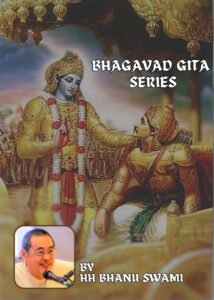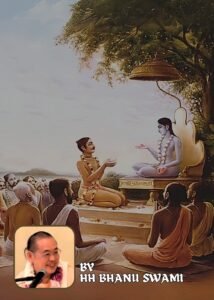Q & A session | HH Bhanu Swami Maharaj | Skopje Macedonia | July 20, 2025
Of course, Caitanya Caritamrita says, you should take the foot water and the foot dust and the Mahaprashadam of a devotee. So, anything related to a devotee is purifying and produces bhakti. So, as I said, not even contacting a devotee, seeing him at a distance, remembering a devotee is purifying. Why, because ultimately, they’re practicing bhakti and because they’re practicing bhakti, within the bhakti, is the Supreme Lord.
Of course, we can say, well, Supreme Lord is in everybody’s, as paramatma, even in the demon. So why isn’t the demon also a Tirtha? Why isn’t he also purifying? We should go to all the demons and get purified. So, when we practice bhakti, something else happens. Paramatma is replaced by Supreme Lord himself as Bhagavan. Paramatma is neutral to everybody. Bhagavan favors the devotee. Supreme Lord is attracted to bhakti. So he’s attracted to the devotee. So, what could be more purifying than a devotee, because the devotee has Krishna in them. So, we can associate with the devotee, by taking his Mahaprashadam or taking his foot dust or foot water, seeing him at a distance, remember, but most powerful way is, to accept the instructions of a devotee.
So, when we talk about devotee association in Bhagavatam, it means association by preaching. So Supreme Lord Himself instructs Brahma, Brahma instructs Narada, Narada instructs Vyasa, Vyasa instructs Sukadeva, Sukadeva instructs Pariksit. We see Jada Bharat instructs King Raghugana. Yeah, so repeatedly, the greatest mercy is giving of instructions. So of course, if the materialist instructs on Bhagavad Gita, no potency. If the devotee does it, then it is non-different from Krishna. Of course, the more advanced the devotee, the more potent is the instruction. But in any case, any devotee has some ability to transmit that message of Bhagavatam and Bhagavad Gita. And this is how they deliver the Jivas in the material world. Bhakti is the only way for deliverance and Bhakti is delivered by devotees. And thus, association of devotees is praised in Srimad Bhagavatam.
Okay, Hare Krishna. Any question?
Q & A
1) You’re in the books in the ..[not clear]. Is it now, after 50 years of preaching, is it a little bit different situation at the moment?
Okay, well, I hope so. Yeah, after the initial five or ten years or whatever, they did that in America. I think it was America mainly. Then they realized, this isn’t working too well and people were having negative reaction.
So, we have people like Vaisheshika, who trains people up, for book distribution. I think in most places, they have some people to train people up. So, what to do and what not to do in terms of distributing books. And in his teaching programs, when he’s teaching people how to distribute books, he says you look for people, who you think are going to be favorable, not people who you think are the worst persons and not going to accept. You look first of all and see if people are a little bit interested, a little bit favorable like that, and you approach those persons.
So, in the beginning of book distribution, there was always competition among the different temples to see who could do more books. So therefore, by hook or crook, by any means, they tried to distribute books, but that’s not encouraged nowadays. So, I think attitude has changed and how to distribute books and, you know, after first 10 years of the movement, just yes.
2) I want to thank you so much for this very clear and sobering lecture and put in very deep and simple words. I really appreciate it. Thank you very much. What should be our meditation before going to Tirtha? Is it the best time to find a sadhu there? And I’m asking from the point of view of maybe like devotedly being more Ghostiyānandī, visiting the holy places where there is more Bhajananandī. Actually, yes, how to prepare, how to meditate, prepare our mind and attitude?
So, in Bhagavatam, of course, if we look, we’ll see that visiting Tirtha is often criticized. There are many Tirthas, some Devatas, and people go to all sorts of Tirthas without much distinction to get some purification from sin.
But performing bhakti, chanting the holy name, taking devotee’s association is a more effective way of getting rid of your sins. But the goal of the devotee is not to simply destroy sins. If we simply destroy sins, we get mukti and devotees don’t want mukti. So devotees want prema. So how do we get prema? Of course, we can do all the different Angas, 64 Angas of Bhakti, but of course, one of the main ones is, chanting the holy name. So even if we can’t go to a holy Tirtha, still chant the holy name. We can get the same effect.
However, in Nectar of Devotion, it is said, if you live in the Holy Dham, you live in Mathura Vrindavan, you live in Navadvipa, this is very good for your bhakti. And in fact, Rupa Goswami points out there are, of all the 64 Angas of Bhakti, five are most important. Most important, of course, is Nama Sankirtan. We have hearing Bhagavatam, association of devotees, we have worshiping the deity, and we have living in the Holy Dham. So though chanting the holy name is our main practice, we can also live in the Holy Dham. If we can’t live, we can visit the Holy Dham. These are good Tirthas for prema.
But of course, in going to the Dhama, then we have to be careful. We do not commit offenses. So we should not commit offenses. We should not think of the Dhama as a material place. We should not exploit the Dhama for material profit. Like we worship the deity without asking for material things, we should go to the Dhama with the greatest respect and devotion.
As explained in this verse, and by Srila Prabhupada in other places, actually, if you are going to the Dhama, the best thing to do there is to meet a great devotee. To meet a great devotee, then again, what is the best association? To get some instructions. But then, Srila Prabhupada, he was also a little bit hesitant for the devotees going to the Holy Dhama. In the Holy Dhama, there are also many people that look like devotees, but maybe they are not devotees. So, people often disguise themselves as exalted saints, but actually, they are not. So, we have to be very careful who we associate with in the Dhama also. Fortunately, ISKCON has temples in Vrindavan and Mayapur, etc., so we should consult with our devotees there and see who are the bona fide devotees with whom we can associate with.
But, of course, Jiva Goswami says, if you can’t go to the Dhama at all, at least you can meditate on the Dhama. And fortunate for people in the world, there are ISKCON devotees all around the world, so you can always get association with devotees, even if you don’t go to the Dhama.
3) If we don’t read about prema, the higher levels of bhakti then we can’t achieve it? Because we consider it to come automatically. Even in your Bhakti Shastra, you said that it’s not thought, also. If you can explain a little bit more about this?
Of course, if we do Bhakti, if we don’t know what the goal is, we can get some results.
We know that, Ajamil chanted the name Narayan, he wasn’t thinking of Narayan at all, he wasn’t thinking of Vaikuntha, he wasn’t thinking of a service in the spiritual world, but he got all of his sins destroyed. That much happened. So, a devotee, who’s intentionally doing Bhakti, but not so much knowledgeable, and he’s practicing mixed Bhakti with all sorts of desires or whatever, he can also advance, he can also even get liberation. And eventually, he can also go to the spiritual world. Though his Bhakti is not pure, he can get better than someone doing Karma Yoga. Yes, he can get something better than a person practicing Karma Yoga, which is Svarga Loka or Brahma Loka. He can get better than someone practicing Jnana Yoga, which is liberation. So, it’s explained that a person has a little bit of Karma, a little material desires mixed with his Bhakti, he can get to Vaikuntha, and he can get Salokya and Sarupya. So definitely, that’s some spiritual goal. It’s good. But that person does not advance to the stage where he experiences full rasa with Krishna.
So, a person, of course, is better, if he practices pure Bhakti. And, of course, if he practices pure Bhakti to Krishna, we expect to go to Krishna, rather than Rama or Vishnu. But then, who was Krishna? So, we have to know Krishna is different from Vishnu. He has two arms. He plays the flute. He lives in Vrindavan. He plays with the cows. So we must distinguish one form of the Lord from another. But more than just appearance or form, we have to understand difference in qualities. And we know the quality of Krishna is different from that of Vishnu. We know that worship of Vishnu is full of Aishwarya, great reverence. We know that, worship of Krishna in Vrindavan has none of that reverence. They don’t see Him as God at all.
If Mother Yasoda saw Krishna as God, she would not take a stick and run after Him. So, we worship Krishna. But we have to know a little bit more about Krishna and about His qualities. And, if we want to be a devotee of Krishna in Vrindavan, we have to know about the devotees. How are they acting? And we have to act similarly. That’s not so difficult if we read Tenth Canto, Bhagavatam, especially the first part of the Tenth Canto, up to chapter 35 or whatever. We get nice descriptions of the devotees, like the cowherd boys, Mother Yasoda, Nanda, and the gopis. And we get nice descriptions of Krishna.
So, we actually, if we want to attain Krishna in Vrindavan, in the spiritual world, we have to cultivate a mood similar to the devotees in Vrindavan. They all have prema, but their prema is different from the prema in Vaikuntha. So, in that sense, we have to know something about the prema of the devotees, if we want to attain something similar. Otherwise, we can worship Krishna and we can worship Krishna with reverence, and then we don’t go to Vrindavan. We may go to Dwaraka instead. So, and that’s, of course, if you’re satisfied with Dwaraka, fine [Laughs]. But if you want to go to Vrindavan, don’t be disappointed if you’re worshipping in the wrong way with the wrong mood. So, the more particular way in which we can worship now, the quicker it is for us to attain that goal in the future.
So, of course, in the material world, they have a similar concept. You have to, if you want to achieve a material goal, you have to really meditate on that goal with great concentration. You can’t just think, well, I want some money and think about it once a year. It’s not going to happen. But, if you’re going to say, money, yes, how much money? And then you’re going to say, exactly, I want $50,000, I want $200,000, I want $200,000 plus, I want this plus, I want that. You get all the details together, and I want it in one year, two years, three years. More specific goal will give better results.
So, the more specific goal of prema we have, the quicker it is and the better result we get. There’s a description of one type of shanta rati in the spiritual world, where the person didn’t fix himself on any particular form of the Lord. So, he worships everybody. He worships Rama and Narashima and Vishnu and Krishna, everybody. So, one day he wakes up and says, I’m going to worship Krishna today. Next day, he wakes up, I’m going to worship Vishnu. And so, he worships everybody. Spiritual world is all spiritual, but it doesn’t get deep rasa. No prema. We get a little bit of shanta rati.
4.) I would like to know how to choose the object of meditation to get prema?
So, association is a big factor. So, those who associate with the Sampradaya of Lord Caitanya, then you’re going to be exposed to Krishna and Radha a lot. You read Caitanya Caritamrita, you’re going to hear all about Madhurya rasa. Of course, if you read Bhagavatam, you’ll see all the rasas, Dasya and Sakya, Vatsalya, Madhurya in the tenth canto. But, Lord Caitanya was emphasizing Radha Krishna is the highest worship of all. So, in the Sampradaya, that gets great emphasis.
Still, even in Lord Caitanya’s Sampradaya, not everybody was in Madhurya rasa. So, we get Vatsalya rasa, and Sakya rasa, and Dasya rasa. So, by hearing and reading the pastimes of Krishna and Vrindavan in the tenth canto, if we develop a particular attraction to certain devotees and how they worship Krishna, then that can be a factor in what we choose to worship as our goal and prema. So, by hearing scripture, by association with devotees, then we get some sort of attraction for more particular type of prema.
5) Why is Madhavendra puri Kalpavriksha?
Well, it’s not explained anywhere. So, generally things like trees in the spiritual world really don’t have the rasa that is available for the human forms, like the gopis or the cowherd boys. So, therefore, Bhagavatam describes the relationships and conversations between Krishna and the people of Vrindavan rather than Krishna and the trees or the cows. Krishna cannot really carry out an elaborate discussion with any of the animals or the plants. So, therefore, it’s a little bit surprising that Madhavendra Puri is a tree.
So, of course, what type of tree? Is this a literal desire tree in the spiritual world or is it a metaphor? Now, by the special mercy in the spiritual world, a person could be a desired tree. Simultaneously, it could be a person. But desire tree probably is chosen, because he is the one that fulfilled everybody’s desires for prema. So, through him, we get a nice line of bhakti very similar to that of Lord Chaitanya. So, in this way, we maybe give him some extra glorification by calling him a desire tree, because he’s the one that fulfills everybody’s desire for Madhurya Prema.
6) I was thinking about how to ask the question because, for example, I’m in a situation where I’m trying to please Krishna, but for example, my husband is an atheist and my children didn’t want to have a conversation about Krishna. And how to transcend our mind, especially I go also to work, and many times the angry from people who are around me is affecting me and putting me in lower gunas. So, how do I protect myself from it? Because it’s very hard…
So, this is not a unique situation. I think that’s a situation with many people, many devotees. And normally, for other spiritual practices and following the Vedas, it would be impossible.
However, the process of Bhakti is very flexible. Furthermore, the Nama Sankirtana is very flexible and also most powerful. So, in any situation, we can practice Bhakti, and we can chant the Holy Name. So, whether you’re in heaven or hell, or young or old, or whatever situation, you can practice Bhakti and chant the Name. So, our particular material situation may be difficult or even hellish, but nevertheless we can transcend that situation through chanting the Name. Some people, by good fortune, they don’t have so many obstacles. So, if we’re in a position, where there are so many obstacles or whatever, we have to tolerate the situation and simply continue our devotion.
And Bhagavatam says that a person who does this, in spite of all the problems, they continue to worship the Lord. They are the ones who get the mercy of the Lord. Of course, by your mere presence, you can also purify family and workers or whatever. They don’t know it. They’re getting benefit. So, this is maybe the only way you can preach to the faithless. Just be there and by that association, they get some benefit.
Hare Krishna !
Devotees: HH Bhanu Swami Maharaj ki jai!!!


